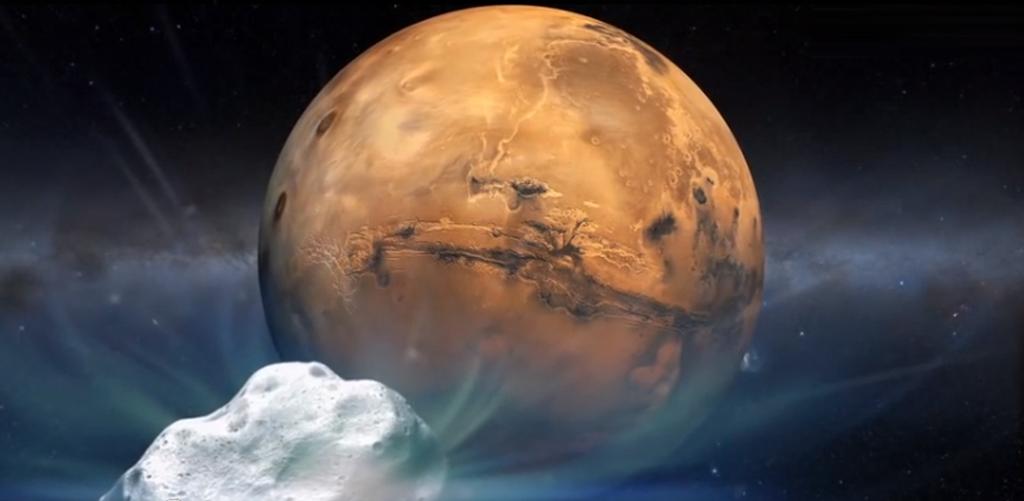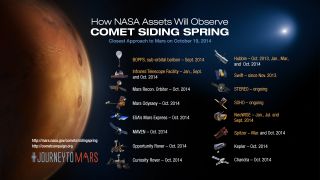
A comet will give Mars a historically close shave next weekend, and NASA aims to be ready for the dramatic cosmic event.
The space agency has already trained a number of its science assets on Comet Siding Spring, which will zoom within 87,000 miles (139,500 kilometers) of Mars on Oct. 19 — about one-third the distance between Earth and the moon. And NASA's fleet of Red Planet orbiters and rovers will be watching on the big day, studying the comet and its influence on Mars' atmosphere.
"On October 19, we're going to observe an event that happens maybe once every million years," Jim Green, director of NASA's planetary science division, said during a news conference today (Oct. 9). "We're getting ready for a spectacular set of observations." [See photos of Comet Siding Spring]
First-time visitor
Comet Siding Spring, also known as C/2013 A1, was discovered in 2013 by astronomer Rob McNaught using Australia's Siding Spring Observatory. The comet is making its first trip through the inner solar system from the frigid, faraway Oort Cloud, which lies about 50,000 astronomical units from the sun. (One astronomical unit, or AU, is the average distance between Earth and the sun — about 93 million miles, or 150 million km).
Because Siding Spring has never been "heat-treated" before, the incoming comet likely remains largely unchanged since its formation 4.6 billion years ago, researchers said. So studying its composition and behavior should provide clues about the conditions that existed at the birth of the solar system.
"That's one of the reasons we study comets — they're the remnants of our solar system's formation," said Padma Yanamandra-Fisher, a senior research scientist at the Space Science Institute's Rancho Cucamonga branch in California.
Observations by a number of missions, including NASA's Hubble, Swift, Spitzer and NEOWISE spacecraft, have already returned some data on Siding Spring. For example, researchers think the comet's core is between 0.5 miles and 5 miles (0.8 to 8 km) in diameter. Further, the fuzzy cloud (or coma) surrounding Siding Spring's nucleus is about 100,000 miles (160,000 km) wide at this point, and its tail stretches for about 300,000 miles (480,000 km), scientists said.
Get the Space.com Newsletter
Breaking space news, the latest updates on rocket launches, skywatching events and more!

But the real show will begin Oct. 19. NASA's three Mars orbiters — Mars Odyssey, the Mars Reconnaissance Orbiter (MRO) and the newly arrived MAVEN spacecraft — will observe Siding Spring's flyby from space, while the agency's Opportunity and Curiosity rovers will watch from the Red Planet's surface.
The goal is to learn more about the comet's size, rotation speed, activity and composition, researchers said. The interactions between comet particles and Mars' atmosphere could also help scientists better understand the Red Planet's air. MAVEN is particularly well suited to perform this latter task, since the mission was designed to study Mars' upper atmosphere (MAVEN is short for Mars Atmosphere and Volatile Evolution).
If all goes according to plan, MRO will take the first-ever good pictures of an Oort Cloud comet's nucleus. And Opportunity and Curiosity could make some history as well, if Martian dust storms don't cloud up the atmosphere too much.
"We certainly have fingers crossed for the first images of a comet from the surface of another world," said Kelly Fast, program scientist at NASA's planetary science division. "That would be really exciting."
Various instruments and assets will continue to watch Siding Spring after the flyby, following the comet as it recedes into space.
Protecting the spacecraft
Siding Spring will barrel past Mars at about 126,000 mph (203,000 km/h) on Oct. 19 — so fast that even tiny particles shed by the comet could do some serious damage to an orbiting spacecraft. So NASA has taken pains to maneuver its Red Planet orbiters out of harm's way.
"When Mars gets very close to the dust tail, which is about 100 minutes after closest approach, all our spacecraft will be on the opposite side of the planet," Green said. "So the planet will provide the additional protection we believe we need to be able to make these observations safely."
Curiosity and Opportunity aren't in any danger, researchers said; the Mars atmosphere, while just 1 percent as dense as that of Earth, is still substantial enough to protect the rovers from incoming comet material.
Follow Mike Wall on Twitter @michaeldwall and Google+. Follow us @Spacedotcom, Facebook or Google+. Originally published on Space.com.
Join our Space Forums to keep talking space on the latest missions, night sky and more! And if you have a news tip, correction or comment, let us know at: community@space.com.

Michael Wall is a Senior Space Writer with Space.com and joined the team in 2010. He primarily covers exoplanets, spaceflight and military space, but has been known to dabble in the space art beat. His book about the search for alien life, "Out There," was published on Nov. 13, 2018. Before becoming a science writer, Michael worked as a herpetologist and wildlife biologist. He has a Ph.D. in evolutionary biology from the University of Sydney, Australia, a bachelor's degree from the University of Arizona, and a graduate certificate in science writing from the University of California, Santa Cruz. To find out what his latest project is, you can follow Michael on Twitter.











